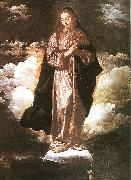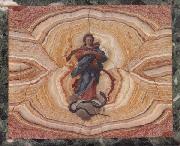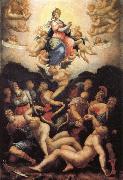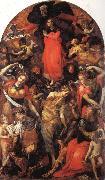Wholesale Oil Painting No Minimum |
|||||||||||
|
|
|||||||||||

|
|||||||||||
|
|
|
||||||||
Diego VelazquezSpanish Baroque Era Painter, 1599-1660 Spanish painter. He was one of the most important European artists of the 17th century, spending his career from 1623 in the service of Philip IV of Spain. His early canvases comprised bodegones and religious paintings, but as a court artist he was largely occupied in executing portraits, while also producing some historical, mythological and further religious works. His painting was deeply affected by the work of Rubens and by Venetian artists, especially Titian, as well as by the experience of two trips (1629-31 and 1649-51) to Italy. Under these joint influences he developed a uniquely personal style characterized by very loose, expressive brushwork. Although he had no immediate followers, he was greatly admired by such later painters as Goya and Manet |
||||||||
|
|
||||||||
The Immaculate Conception
The Immaculate Conception Painting ID:: 740 |
National Gallery, London, England National Gallery, London, England |
|||||||
|
|
||||||||
|
|
||||||||
|
|
The immaculate conception
The immaculate conception Painting ID:: 27580 |
mk56
oil on alabastro fiorito,set within a verde antico border
mk56 oil on alabastro fiorito,set within a verde antico border |
||||||
|
|
||||||||
Giovanni Battista TiepoloItalian Rococo Era Painter, 1696-1770 Giovanni Battista Tiepolo was born in Venice on March 5, 1696. His father, who was part owner of a ship, died when Tiepolo was scarcely a year old, but the family was left in comfortable circumstances. As a youth, he was apprenticed to Gregorio Lazzarini, a mediocre but fashionable painter known for his elaborately theatrical, rather grandiose compositions. Tiepolo soon evolved a more spirited style of his own. By the time he was 20, he had exhibited his work independently, and won plaudits, at an exhibition held at the church of S. Rocco. The next year he became a member of the Fraglia, or painters guild. In 1719 he married Cecilia Guardi, whose brother Francesco was to become famous as a painter of the Venetian scene. They had nine children, among them Giovanni Domenico and Lorenzo Baldassare, who were also painters. In the 1720s Tiepolo carried out many large-scale commissions on the northern Italian mainland. Of these the most important is the cycle of Old Testament scenes done for the patriarch of Aquileia, Daniele Dolfin, in the new Archbishop Palace at Udine. Here Tiepolo abandoned the dark hues that had characterized his early style and turned instead to the bright, sparkling colors that were to make him famous. |
||||||||
|
|
||||||||
|
|
The Immaculate Conception
The Immaculate Conception Painting ID:: 28139 |
mk61
1767-1769
Oil on canvas
279x152cm
mk61 1767-1769 Oil on canvas 279x152cm |
||||||
|
|
||||||||
Giorgio Vasari1511-74 Italian painter, architect, and writer. Though he was a prolific painter in the Mannerist style, he is more highly regarded as an architect (he designed the Uffizi Palace, now the Uffizi Gallery), but even his architecture is overshadowed by his writings. His Lives of the Most Eminent Architects, Painters, and Sculptors (1550) offers biographies of early to late Renaissance artists. His style is eminently readable and his material is well researched, though when facts were scarce he did not hesitate to fill in the gaps. In his view, Giotto had revived the art of true representation after its decline in the early Middle Ages, and succeeding artists had brought that art progressively closer to the perfection achieved by Michelangelo. |
||||||||
|
|
||||||||
|
|
The Immaculate Conception
The Immaculate Conception Painting ID:: 29858 |
mk67
Oil on panel
22 13/16x15 3/4in
Uffizi,Gallery
mk67 Oil on panel 22 13/16x15 3/4in Uffizi,Gallery |
||||||
|
|
||||||||
Carlo Portellic. 1508 - Florence 1574 |
||||||||
|
|
||||||||
|
|
The Immaculate Conception
The Immaculate Conception Painting ID:: 29868 |
mk67
Oil on panel
163x96 7/8in
mk67 Oil on panel 163x96 7/8in |
||||||
|
|
||||||||
ZURBARAN Francisco deSpanish Baroque Era Painter, 1598-1664 Spanish painter. He was apprenticed in 1614 to a painter in Sevilla (Seville), where he lived until 1658 when he moved to Madrid. He had a few royal commissions but remained throughout his life a provincial painter of religious pictures. His apostles, saints, and monks are painted with almost sculptural modeling, and his emphasis on the minutiae of their dress lends verisimilitude to their miracles, visions, and ecstasies. This distinctive combination of naturalism with religious sensibility conforms to the guidelines for Counter-Reformation artists outlined by the Council of Trent. He had numerous commissions from monasteries and churches throughout southern Spain, and many of his works were sent to Lima, Peru. |
||||||||
|
|
||||||||
|
|
The Immaculate Conception
The Immaculate Conception Painting ID:: 52701 |
1661 Oil on canvas, 136,5 x 102,5 cm 1661 Oil on canvas, 136,5 x 102,5 cm |
||||||
|
|
||||||||
El GrecoGreek-born Spanish Mannerist Painter, 1541-1614 Considered a representative of late Renaissance Spanish art, El Greco was actually born in Greece, on the island of Crete. After studying in Venice under Titian, El Greco settled in Toledo, Spain in 1577. At the time he was wildly popular, his emotionally religious paintings being just the ticket for the hometown of the Spanish Inquisition. After his death his work was largely ignored until the beginning of the 20th century; now he considered one of the inspired geniuses of Western art. His distinctive style features bold shapes and colors, with elongated and slightly distorted figures. In Toledo El Greco was in constant demand and liked living large: he maintained a private orchestra to accompany his meals. |
||||||||
|
|
||||||||
|
|
The Immaculate Conception
The Immaculate Conception Painting ID:: 53605 |
mk233
1607-1613
Oil on canvas
347x174cm
mk233 1607-1613 Oil on canvas 347x174cm |
||||||
|
|
||||||||
|
El Greco Greek-born Spanish Mannerist Painter, 1541-1614 Considered a representative of late Renaissance Spanish art, El Greco was actually born in Greece, on the island of Crete. After studying in Venice under Titian, El Greco settled in Toledo, Spain in 1577. At the time he was wildly popular, his emotionally religious paintings being just the ticket for the hometown of the Spanish Inquisition. After his death his work was largely ignored until the beginning of the 20th century; now he considered one of the inspired geniuses of Western art. His distinctive style features bold shapes and colors, with elongated and slightly distorted figures. In Toledo El Greco was in constant demand and liked living large: he maintained a private orchestra to accompany his meals. The Immaculate Conception mk233 1607-1613 Oil on canvas 347x174cm |
||||||||
|
|
||||||||
|
Prev Next
|
||||||||
|
|
||||||||
|
Related Paintings to El Greco :. |
||||||||
|
|
||||||||
|
CONTACT US |







